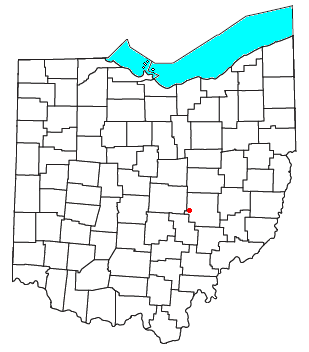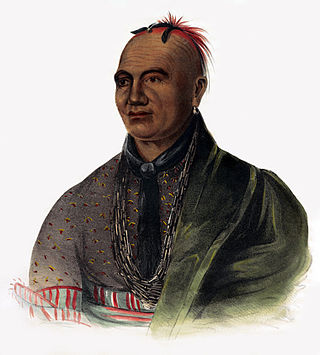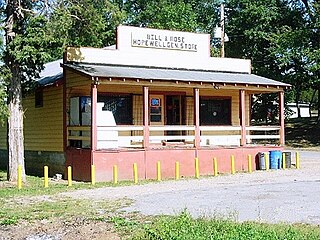
Hopewell is an independent city surrounded by Prince George County and the Appomattox River in the Commonwealth of Virginia, United States. At the 2020 census, the population was 23,033. The Bureau of Economic Analysis combines the city of Hopewell with Prince George County for statistical purposes.
Hopewell is a town in Ontario County, New York, United States. The population was 3,841 at the 2020 census.

The Hopewell tradition, also called the Hopewell culture and Hopewellian exchange, describes a network of precontact Native American cultures that flourished in settlements along rivers in the northeastern and midwestern Eastern Woodlands from 100 BCE to 500 CE, in the Middle Woodland period. The Hopewell tradition was not a single culture or society but a widely dispersed set of populations connected by a common network of trade routes.

Hopewell is an unincorporated community in central Hopewell Township, Muskingum County, Ohio, United States.

The Tri-Cities of Virginia is an area in the Greater Richmond Region which includes the three independent cities of Petersburg, Colonial Heights, and Hopewell and portions of the adjoining counties of Chesterfield, Dinwiddie, and Prince George in south-central Virginia. Other unincorporated communities located in the Tri-Cities area include Ettrick, Fort Lee, and City Point, the latter formerly a historic incorporated town which was annexed to become part of the City of Hopewell.

Indigenous peoples of the Northeastern Woodlands include Native American tribes and First Nation bands residing in or originating from a cultural area encompassing the northeastern and Midwest United States and southeastern Canada. It is part of a broader grouping known as the Eastern Woodlands. The Northeastern Woodlands is divided into three major areas: the Coastal, Saint Lawrence Lowlands, and Great Lakes-Riverine zones.

The Toolesboro Mound Group, a National Historic Landmark, is a group of Havana Hopewell culture earthworks on the north bank of the Iowa River near its discharge into the Mississippi. The mounds are owned and displayed to the public by the State Historical Society of Iowa. The mound group is located east of Wapello, Iowa, near the unincorporated community of Toolesboro.

The Kincaid Mounds Historic Site c. 1050–1400 CE, is a Mississippian culture archaeological site located at the southern tip of present-day U.S. state of Illinois, along the Ohio River. Kincaid Mounds has been notable for both its significant role in native North American prehistory and for the central role the site has played in the development of modern archaeological techniques. The site had at least 11 substructure platform mounds, and 8 other monuments.

Llanidan is a community in the south of Anglesey, Wales which includes the village of Brynsiencyn. The parish is along the Menai Strait, about 4 miles north-east of Caernarfon. The parish church of St Nidan is near the A4080 highway, a little to the east of Brynsiencyn. The ruins of an earlier parish church survive.

Hopewell is an unincorporated community and former American borough which is located in Chester County, Pennsylvania, United States.
Hopewell is an unincorporated community in Hillsborough County, Florida, United States. It lies at an elevation of 102 feet (31 m) above sea level. Hopewell is located along Florida State Road 60 at the intersection of Hillsborough County Road 39 and southern terminus of Florida State Road 39.

Hopewell is an unincorporated community in eastern Washington County, Missouri, United States. The community lies on Hopewell Creek, south of Summit and Missouri Route 8.

The Havana Hopewell culture were a Hopewellian people who lived in the Illinois River and Mississippi River valleys in Iowa, Illinois, and Missouri from 200 BCE to 400 CE.

Mount Rose is an unincorporated community located within Hopewell Township, in Mercer County, New Jersey, United States, situated at the corner of Carter Road, Pennington-Rocky Hill Road, and Cherry Valley Road. It is named for a local gardener. The Mount Rose section of Rocky Hill Ridge through the community also takes its name from the gardener. Richard Stout opened the first general store in the village around 1822 and in 1830, Josiah Cook and Reuben Savidge opened a second store. The settlement was also later home to two shoe shops, a dressmaker, wheelwrights, a blacksmith, a harness shop, an agricultural implements warehouse, a post office and a steam sawmill. In its heyday the community had about 20 houses. Nathaniel Drake opened an applejack distillery in the village in the mid-19th century. He made and sold peach brandy, apple cider and apple whiskey. The Whiskey House, the office building for the distillery and the only remaining Drake building in the village, is listed on the township, state and national registers of historic places. The community's schoolhouse, a stone building east of the crossroads, was later replaced by a frame building on the southern end of the village that is a private residence today. After 1880, Mount Rose began shrinking, due to the growth of nearby Hopewell. It is planned that the Lawrence Hopewell Trail will go through the community.
Larland was a rural unincorporated community in Audubon County, Iowa, in the United States. It was located about 9 miles east of Aududon, the county seat, in Melville Township.
Cottonville is an unincorporated community in Jackson County, Iowa, United States.
Canby is an unincorporated community in Adair County, in the U.S. state of Iowa.

Ceres is an unincorporated community in Clayton County, Iowa, United States. Ceres once had a post office, which has since been abandoned. The county seat of Elkader lies approximately 11 miles to the west.
Nansen was an unincorporated community in Chickasaw County, Iowa, United States. It was at the junction of 170th Street and Pembroke Avenue.















